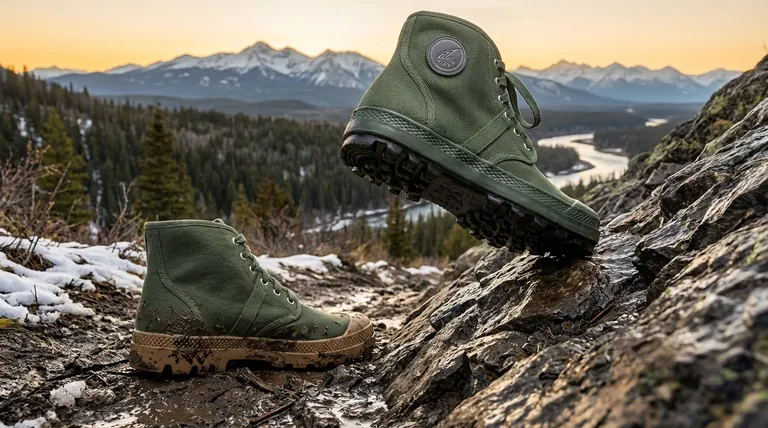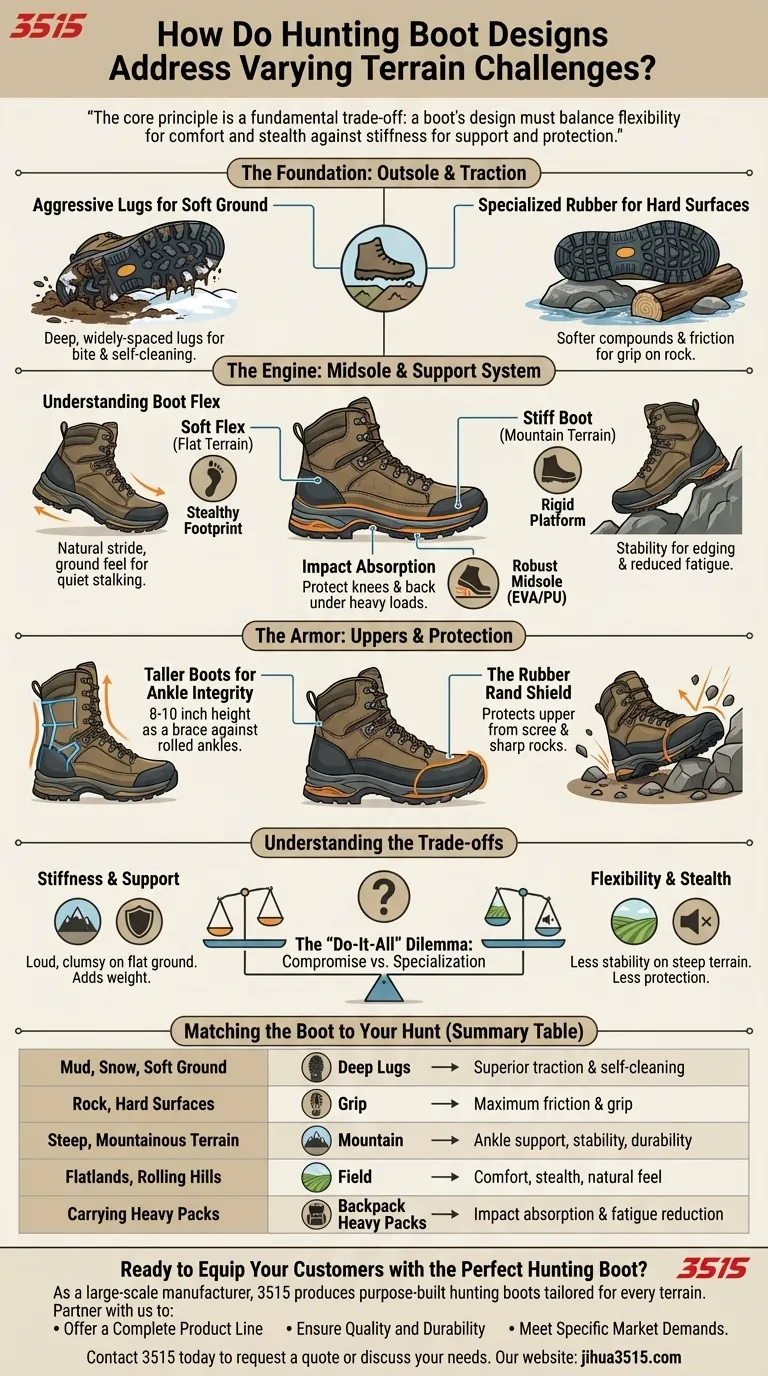In short, hunting boots are purpose-built systems. They address varying terrain challenges by strategically combining specific outsole tread patterns, midsole stiffness, upper height, and protective materials to create a tool optimized for a specific environment.
The core principle is a fundamental trade-off: a boot's design must balance flexibility for comfort and stealth against stiffness for support and protection. The right boot isn't the most expensive one; it's the one whose design philosophy perfectly matches the terrain you will encounter most often.

The Foundation: Outsole and Traction
A boot’s connection to the ground is its most critical function. The outsole is engineered to provide predictable grip across surfaces that can change from one step to the next.
Aggressive Lugs for Soft Ground
For hunts in mud, snow, or loose dirt, the key feature is deep, widely-spaced lugs. This aggressive tread pattern allows the boot to bite into soft surfaces for traction. The spacing helps the outsole shed mud and debris, preventing it from caking up and turning into a useless, flat surface.
Specialized Rubber for Hard Surfaces
On rock, logs, or other hard surfaces, traction comes from the friction of the rubber compound itself. Softer rubber compounds provide better grip, especially on wet rock, but may wear faster. The specific pattern and surface area of the lugs also play a role in maximizing contact with the ground.
The Engine: Midsole and Support System
The midsole dictates how the boot feels underfoot and how it supports your body weight, especially when carrying a heavy pack. It is the primary source of a boot's stiffness and shock absorption.
Understanding Boot Flex
A boot’s flex rating is its most defining characteristic for terrain matching. A softer flexing boot is ideal for flat or gently rolling terrain, as it allows for a more natural stride and better "feel" of the ground, which aids in quiet stalking.
Conversely, a stiff boot is essential for mountains. It creates a rigid platform that prevents your foot from bending over rocks and provides stability when "edging" on steep sidehills. This stiffness reduces foot fatigue on long, challenging climbs.
Impact Absorption
During long descents, especially with the added weight of a pack, your joints take a tremendous pounding. The midsole, often made of materials like EVA or Polyurethane, is designed to absorb this impact, protecting your knees and back from repetitive stress.
The Armor: Uppers and Protection
The upper part of the boot shields your foot and ankle from the environment, providing both protection from impacts and crucial structural support.
Taller Boots for Ankle Integrity
Boots in the 8- to 10-inch height range provide significant ankle support. On uneven, rocky, or off-camber ground, this height acts as a brace, drastically reducing the risk of a rolled ankle, which can be a hunt-ending injury.
The Rubber Rand Shield
Many mountain-focused boots feature a rubber rand, which is a thick band of rubber wrapping around the lower portion of the boot. Its sole purpose is to protect the leather or synthetic upper material from being shredded by sharp rocks and scree, dramatically increasing the boot's durability.
Understanding the Trade-offs
Choosing a hunting boot is an exercise in compromise. Excelling in one environment often means sacrificing performance in another.
Stiffness vs. Stealth
A stiff mountain boot that provides an unyielding platform on rock is loud and clumsy when trying to stalk quietly through a forest. You lose the ability to feel branches underfoot before they snap, alerting every animal in the area.
Support vs. Weight
The features that provide maximum support and protection—taller uppers, stiffer midsoles, and rubber rands—all add weight. While essential in the mountains, this extra weight leads to unnecessary fatigue on long treks over flat terrain where such robust support is not required.
The "Do-It-All" Dilemma
Some boots are designed to be generalists, blending moderate stiffness with decent comfort. While these are excellent for hunters who face highly varied terrain in a single outing, they will never outperform a specialized boot at either end of the spectrum.
Matching the Boot to Your Hunt
Use the terrain as your guide to filter your options and find the right design.
- If your primary focus is flatlands, fields, or rolling hills: Prioritize a more flexible boot for all-day comfort and a quieter step.
- If your primary focus is steep, mountainous, or rocky terrain: You need a stiff boot with excellent ankle support (taller height) and a protective rubber rand.
- If your primary focus is carrying heavy packs over long distances: Focus on boots with a robust midsole and shank for critical underfoot support to prevent fatigue.
- If your primary focus is wet, muddy, or snowy conditions: Look for an outsole with deep, aggressive, and widely-spaced lugs for maximum traction.
By understanding how these design elements function as a system, you can select a boot that acts as a reliable tool for your specific hunting environment.
Summary Table:
| Terrain Challenge | Key Boot Design Features | Primary Benefit |
|---|---|---|
| Mud, Snow, Soft Ground | Deep, widely-spaced lugs | Superior traction & self-cleaning |
| Rock, Hard Surfaces | Soft rubber compound, specific lug pattern | Maximum friction & grip |
| Steep, Mountainous Terrain | Stiff midsole, 8-10 inch upper, rubber rand | Ankle support, stability, and durability |
| Flatlands, Rolling Hills | Flexible midsole, lower profile | Comfort, stealth, and natural feel |
| Carrying Heavy Packs | Robust midsole with shank | Impact absorption & fatigue reduction |
Ready to Equip Your Customers with the Perfect Hunting Boot?
As a large-scale manufacturer, 3515 produces a comprehensive range of hunting boots tailored for every terrain. We provide distributors, brand owners, and bulk clients with high-performance footwear that combines the right traction, support, and protection.
Partner with us to:
- Offer a Complete Product Line: From flexible boots for quiet stalking to stiff, supportive boots for mountain expeditions.
- Ensure Quality and Durability: Benefit from our manufacturing expertise in materials like specialized rubber compounds and protective rands.
- Meet Specific Market Demands: We can tailor designs to match the precise terrain challenges your customers face.
Let's discuss how we can support your business with reliable, purpose-built hunting boots.
Contact 3515 today to request a quote or discuss your needs
Visual Guide

Related Products
- Factory-Direct Wholesale Canvas Boots with High-Traction Rubber Soles
- Durable Spiked Camouflage Boots Wholesale & Factory Production
- Durable Leather Tactical Boots Wholesale & Custom Manufacturing for Brands
- Safety Footwear Wholesale Manufacturer for Custom OEM/ODM Production
- Wholesale Waterproof Tactical Boots Custom Suede & High-Traction Soles
People Also Ask
- What are the advantages of rubber soles in safety boots? Unbeatable Grip & Durability
- Why is rubber commonly used for non-slip soles? The Science of Superior Grip
- What should be avoided when storing boots with outsoles? Protect Your Investment from Dry Rot & Decay
- What is a vulcanized sole? Discover the Secret to Superior Flexibility and Grip
- Why is rubber a popular material for shoe soles? Unbeatable Grip, Durability & Value



















